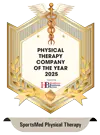Do your hips feel different as the years pass by? Do your knees come forward excessively during functional movements like squatting or lunging? These are all signs of a lack of hip hinging mechanics due to weak gluteal muscles, which carries forward to a dysfunctional body.
The gluteal muscles consist of three muscle groups that form your buttocks — gluteus maximus, gluteus medius, and gluteus minimus. To understand the best workout for a weak hip, it is important to understand the function that each muscle group performs and how it is affecting your hips. The gluteus maximus extends and rotates the thigh laterally while the medius and minimus work to abduct and rotate the thigh medially.
Often times, patients experiencing a weak gluteal muscles their symptoms and problems from a sedentary lifestyle. Long periods of sitting in a chair causes the hip flexors (front of the hips) to become shorter and tighter while your gluteal muscles start elongating and weakening. After months and years of prolonged seating, your body forgets how to utilize the gluteal muscles and command the movement of other stronger muscles in the area. This is what causes hip injuries from sitting, standing or even walking.
Here’s an entire workout to address your weak gluteal muscle activation:
First Exercise: The Bridge
Form a bridge with your hips in the air supported by both your leg and holds your core for 30 seconds. Your knees should be 90 degrees, with your thighs and hips parallel to each other. Squeeze your gluteal muscles when your hips are in the air to ensure maximum activation of the muscle group. Lower the hips and repeat the exercise for three times with minimal rest in between.
Second Exercise: Stationary Lunge
Stand tall and lunge forward with the right leg to assume a stationary lunge position. Keep your core tight and engaged as you keep your right knees behind the ankle and your back in a neutral position. You will feel a stretch in your hip flexors and may even experience some intense vibrations in your body from the built up tension in your tight muscles. Repeat with the other leg for a total of three consecutive times.
Final exercise: Supine Piriformis Stretch
This exercise is great especially for those that have occasional pain running down from your lower back to your feet. Start by lying on your back, with one foot on top of the other knee. The supporting leg is placed at an angle slightly below 90 degrees from the knee joints. Pull your supported leg towards the opposite shoulder and you should feel the stretch along your gluteal muscles.
Perform this workout twice every three days, preferably before your day begins and after it ends. You’ll find that pain from your lower back will gradually ease off and your posture will improve dramatically.



